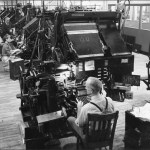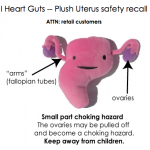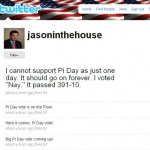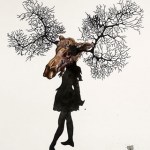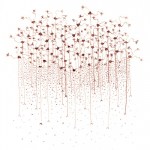
Via Morbid Anatomy: the Discovery Channel series "How It's Made" features the construction of modern anatomical models. You can watch the five-minute segment after the fold.
Discovery Channel, "How It's Made", Season 11, Episode 2/Part 1
Linotype operators work in the composing room at the P-I building at 6th and Wall Street in December, 1948. (Seattle Post-Intelligencer photo)
To follow up on my post about science journalism and blogs, a few reading links dealing with science in society, journalism, and the transformation of media.
First, Peter Dizikes revisits C.P. Snow's ubiquitous "two cultures", fifty years later:
"The Two Cultures" actually embodies one of the deepest tensions in our ideas about progress. Snow, too, wants to believe the sheer force of science cannot be restrained, that it will change the world -- for…
This revealing anatomical card by Oregon designer Nathan Chrislip can be had for only $9 plus shipping on etsy. (Chrislip calls it a "valentine," but unless your beloved is also an avowed anatomophile, be sure to enclose a message making your nonviolent romantic intent clear.)
Via Rag and Bone Blog
This is pretty darn good for Stanford students! ;)
Ready for the final?
Illustration by David Parkins, Nature
Today, Nature released a news feature by Geoff Brumfiel on the downturn in mainstream science media. We've all known that this is happening; the alarms become impossible to ignore when Peter Dysktra and his team at CNN lost their jobs last year. For mainstream outlets like CNN or the Boston Globe to cut science may seem appalling - but in an unforgiving economic climate which has already triggered the collapse of major newspapers like the Seattle Post-Intelligencer, such cuts are logical, because science reporting isn't a big money-maker. The question…
After reading my pitiable lament about the demise of several domestic artisan chocolate factories, my friend wunx sent me two bars of Amano chocolate! Yum! I don't know why it seems so odd to me that good dark chocolate is being made just outside Salt Lake City, but Amano's product is delicious. I highly recommend both the Madagascar and the Ocumare; the Madagascar is sharp with a tangy citrus note, while the Ocumare is smoother. I can tell you that both go wonderfully with a nice pinot noir.
Amano also has a rather nice chocolate blog - check out their historical look at a chocolate factory…
Via Bora's blog, a delightfully cheesy1955 filmstrip about why science education is more important than anything else - even fishing. It starts out slow, but this Sputnik-era treasure turns into a veritable propagandafest about how science literacy is a civic duty. Plus, it raises vital questions like "Why do these kids have weird pseudo-Southern accents even though their parents don't?" and "How can science help Betty 'hook some guy'?"
Remember, women need to know as much about science as some men do! Are you going to be ready?
(Look how bored Betty looks by the end.)
Provenance:…
I know I've typed out some howlers in my day, so I say this with all due humility. But this post over at iO9 had me rolling on the floor last night:
Paul Murtaugh, a statistician at Corvallis' Oregon State University, claims that our carbon legacy isn't just limited to our own emissions, but 50% of our children's (The other parent gets the other 50%). And 25% of their children's, and so on, and so on. He arrived at this estimate using math: Murtaugh used UN population projections, which say that after 2050, birth rates in all countries will be 1.85 children per woman, on average. Then he took…
About two weeks ago I went to Politics and Prose for a great talk by the New Yorker's Adam Gopnik, who was in DC promoting his new book, Angels and Ages, a book of essays about Charles Darwin and Abraham Lincoln. The words and actions of these two influential men - some would call them secular saints - still reverberate today. And coincidentally, they were also born just hours apart, on the same day: February 12, 1809.
Gopnik explicitly said that he did not intend to suss out any mystical or astrological significance to the shared birthday: it's a coincidence, and nothing more. But as he…
I don't know how in hell I missed this one, but thank heavens A Repository for Bottled Monsters alerted me to the "Uterine Plush Recall" over at I Heart Guts! Apparently the uterus "failed a pull test" and "the ovaries may be pulled off and become a choking hazard"! I do not think I am alone in saying eeeuuuuww!
I Heart Guts assures us that rest of their smiling fuzzy internal organs are perfectly safe for all ages, but if you are in possession of a smug, Thriller video-dancing, pink plush uterus with hazardous trachea-sized violet ovaries, please contact appropriate support personnel…
You've probably heard about the man with the eyeball camera. Here's the most detailed (and sometimes graphic) video I've yet seen about documentary filmmaker Rob Spence (aka Eyeborg), who is working on getting his prosthetic eye replaced with a wireless eye socket camera:
I first encountered Spence in this writeup at Wired last fall. According to the new video, they've hit a few snags since then, but for some reason Spence is all over the news right now. And it's a safe bet he'll continue to be, if he becomes the first cyborg reporter with a bionic eyecamera!
More: a briefer AP video on…
The Pi Day bill went up for a vote today and passed 391-10. Now Congressman Jason Chaffetz explains (via Twitter, natch) why he dared vote against the hallowed number:
Fie, fie! No Yes PeCan Pi for you, Representative Chaffetz (R-Utah)! But kudos for a creative excuse.
Here in DC, creative individuals appear to have revised Chevron ads in at least one Metro station to reflect a more, er, politically overt sentiment. The poster hack changes the promise "I will use less energy" in this ad (pdf) to "I will stop lobbying against climate legislation."
The digitally executed revision (which looks pretty convincing in person) follows in the footsteps of Berlin graffiti artists and others who use graphic hacks to subtly shift, reverse, or critique advertising in public places. The question is, how many people have noticed? (Keep your eyes open, DC residents!)
As of today, SEED has a new look and a new occasional writer. . . me! ;)
See my little essay on Christopher Reiger's Synesthesia #1 here, on the culture page. Then go explore the rest of the site. . . the new design is pretty sweet. They even have a SCIART tag for pieces like mine.
Throne
Rene Lynch
I was very happy to hear that Pam of Phantasmaphile is curating her first group show, entitled "Fata Morgana: The New Female Fantasists." It starts later this week at Dabora Gallery in Greenpoint, Brooklyn. Pam has amazing taste in art, and she's enticed Madeline von Foerster, Amy Ross, Carrie Ann Baade, and eleven more artists to share their visions:
In literal terms, a fata morgana is a mirage or illusion, a waking reverie, a
shimmering of the mind. Named for the enchantress Morgan le Fay, these tricks
of perception conjure up a sense of glimpsing into another world,…
Thought Patterns #1
blood on watercolor paper
Laura Splan, 2003
The International Museum of Surgical Science in Chicago is calling for proposals for "Anatomy in the Gallery:"
[This program] showcases medically themed contemporary art within the unique context of the Museum's historical collections and exhibits. The program was begun in 1998 to help fulfill the Museum's mission of enriching its visitors' lives by enhancing their knowledge and understanding of surgery and related sciences.
Previous exhibitors include Laura Splan (above), Laura Kurtenbach, Geraldine Ondrizek, and Dominic Paul…
So I observed Pi day by baking a pie. But Representative Bart Gordon of Tennessee, Chairman of the House Committee on Science and Technology, has a much grander idea: let's pass a resolution!
Witness H.Res.224, introduced yesterday:
Supporting the designation of Pi Day, and for other purposes.
Whereas the Greek letter (Pi) is the symbol for the ratio of the circumference of a circle to its diameter;Whereas the ratio Pi is an irrational number, which will continue infinitely without repeating, and has been calculated to over one trillion digits;Whereas Pi is a recurring constant that has…
Rumor has it there's going to be a no-holds-barred culinary throwdown here at Scienceblogs in honor of Pi Day. Personally, I need little excuse to make a pie. And the staffer needs little excuse to eat pie - particularly pecan pie. So here is my entry. . . .the "Yes, PeCan" Pi.
As pies go, this is a simple one that can handle some imprecision. It's a little different every time I do it. And in the spirit of 3.141592-oh-whatever-who-cares, I embrace freely rounding off quantities whenever I feel like it.* In fact, I used my ubercool but uberimprecise Equal Measure to make this Pi:
"Yes,…
Yuval Levin has an editorial in today's WaPo that makes a very good point:
Science policy is not just a matter of science. Like all policy, it calls for a balancing of priorities and concerns, and it requires a judgment of needs and values that in a democracy we trust to our elected officials. In science policy, science informs, but politics governs, and rightly so. There are, of course, different ways for politics to exert authority over science. To distort or hide unwelcome facts is surely illegitimate. But to weigh facts against societal priorities -- economic, political and ethical -- in…
The President just released a new memorandum on scientific integrity:
Science and the scientific process must inform and guide decisions of my Administration on a wide range of issues, including improvement of public health, protection of the environment, increased efficiency in the use of energy and other resources, mitigation of the threat of climate change, and protection of national security. The public must be able to trust the science and scientific process informing public policy decisions. Political officials should not suppress or alter scientific or technological findings and…
